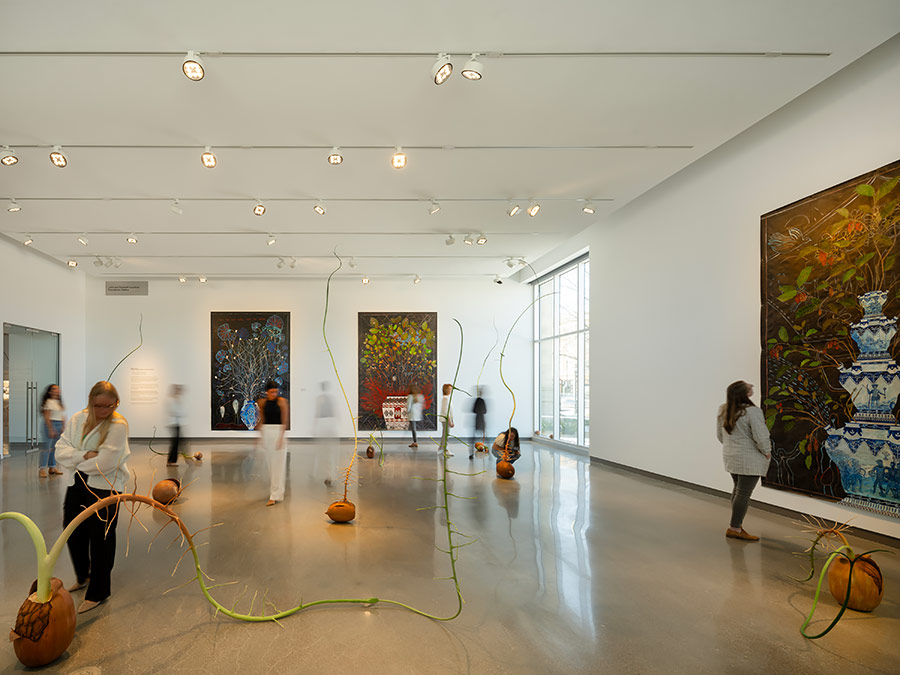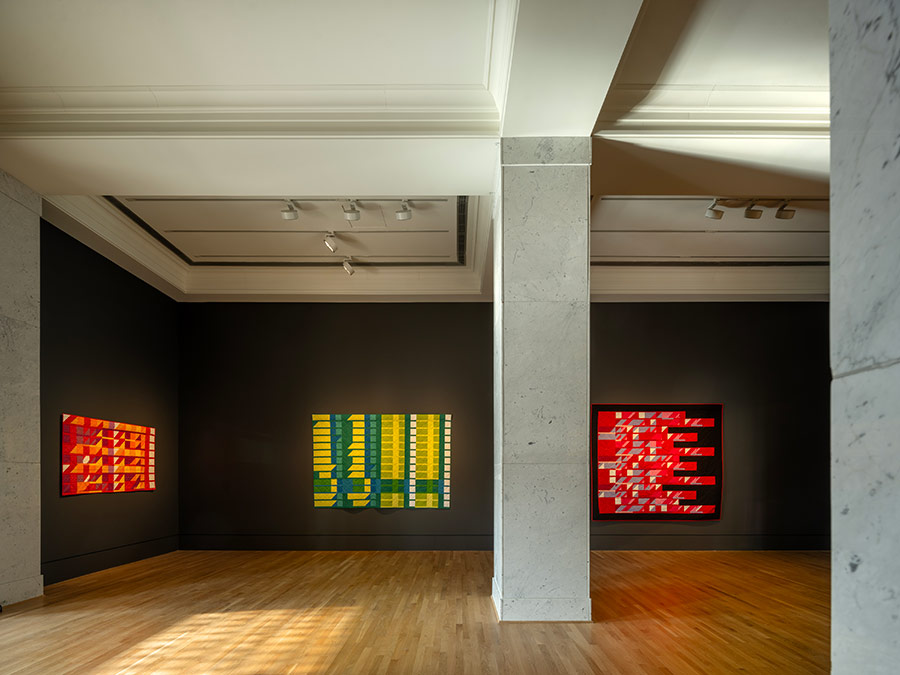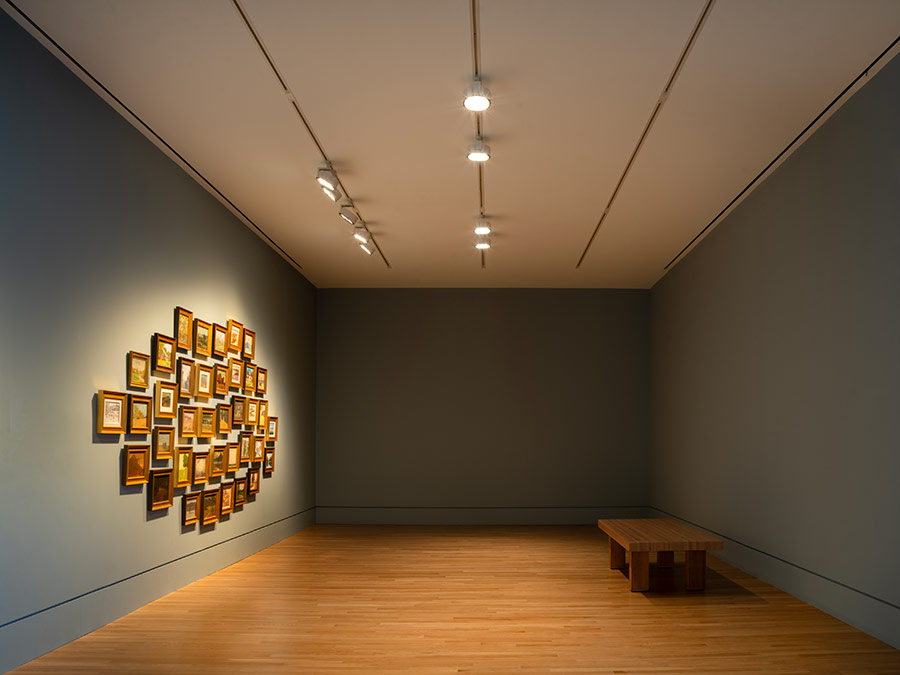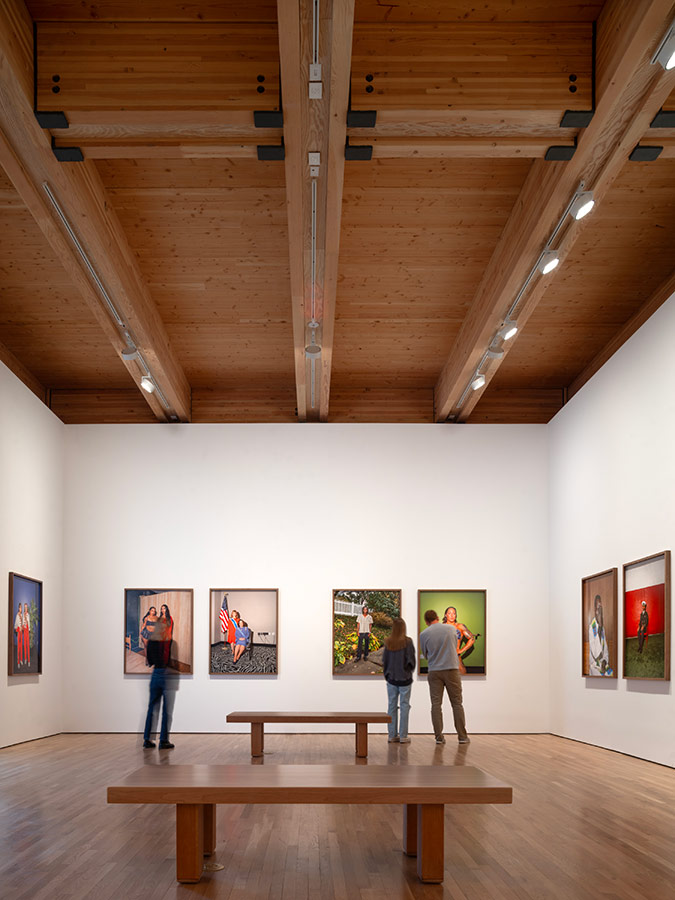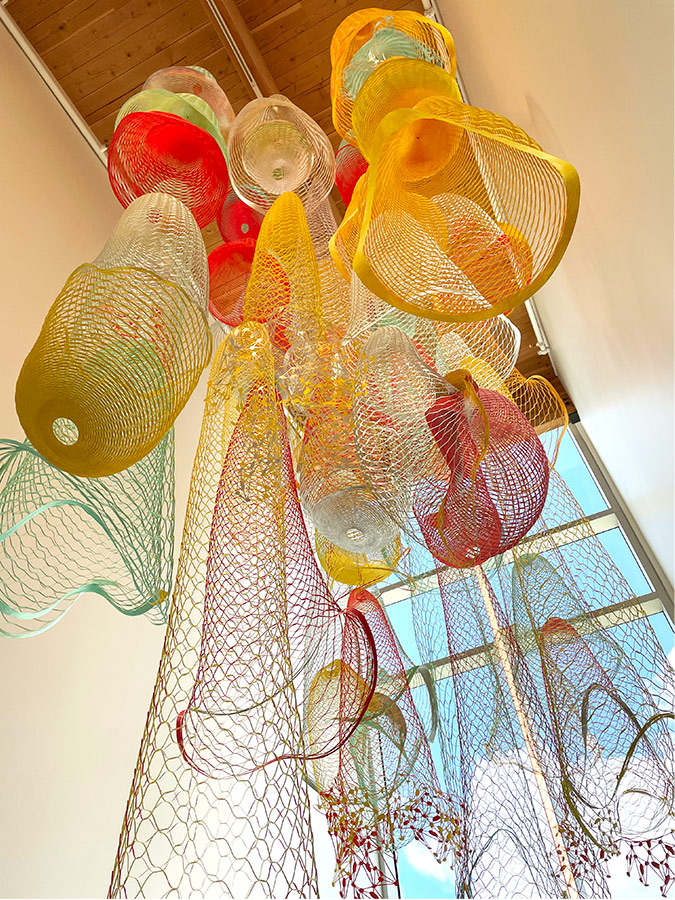Magic and Loss: Charley Friedman and Nancy Friedemann-Sánchez
May 3-July 20, 2025
There’s a bit of magic in everything
And then some loss to even things out
Lou Reed, lyrics from his 1992 song, “Magic and Loss”
We all have experienced moments of magic and loss in our lives; the presence of both is a natural part of life. Groups of people and entire cultures can share these binding experiences. In this exhibition, married artists Charley Friedman and Nancy Friedemann-Sánchez introduce new bodies of work employing the interplay of magic and loss as a thematic and visual device.
Charley Friedman’s playful and lifelike sculptures question humankind’s dominion over the natural world. By enlarging and animating something as small and ordinary as an acorn, Friedman challenges the conventions of human scale and our tolerance for perceived unchecked and unnatural growth.
Nancy Friedemann-Sánchez’s monumental paintings intertwine the personal and political implications of colonialism and cultural hybridity. Her richly layered and bountiful still-lifes reference Spanish colonization, decorative arts, and flora and fauna from the Americas as symbols of conflict and alchemy.
Presented here as separate but related bodies of work, this exhibition invites viewers to join the artists’ conversation about creation, corruption, and destruction—and the inherent magic and loss within.
Special thanks to Kyle Nobles and Shelby Austin Tourney for their studio and exhibition assistance. The texts in Nancy Friedemann-Sánchez’s paintings are excerpted from Farid Matuk’s poems from the pair’s collaborative artist book Redolent, published by Singing Saw Press in 2022.
Photograph © Nic Lehoux
Eliza Hardy Jones: Song Quilts
May 3-December 31, 2025
How can the ephemeral, short-lived experience of a musical performance be expressed in a tangible, enduring art form?
Musician and quiltmaker Eliza Hardy Jones explores this question in her Song Quilts project. Jones traveled across the U.S. and Northwest Russia recording folk songs sung by women, which she then transcribed into written music. Next, she developed a notation method that translates pitch—the highness or lowness of a sound—into color, and rhythm into shape. The resulting quilts are “read” from top left to bottom right. Jones selected predominant colors and quilting patterns to reflect her impressions of the song, the singer, and the experience of sharing music. With each quilt, Jones materialized the women’s voices as they sang to preserve their communities’ traditions and identity.
To listen to each quilt’s song on your smartphone, scan the QR code at the bottom of each quilt’s label.
Eliza Hardy Jones (b. 1980) is a quiltmaker and internationally touring musician, singer, and songwriter from Philadelphia, Pennsylvania. She currently tours with Grammy-nominated artists Iron & Wine and Grace Potter, in addition to releasing her own original music. Jones has given talks on her quilts across the U.S. and in Russia, and her work has been featured in various quilt publications. According to Jones, she “inherited a love of stitch and song from a long line of wild women, musicians, and seamstresses.”
Eliza Hardy Jones: Song Quilts was organized and presented by the International Quilt Museum in Lincoln, Nebraska, February 6 – April 14, 2020.
Photograph © Nic Lehoux
Plein Air Paintings from the Flatwater Folk Art Museum
May 3-December 31, 2025
During the mid-1800s, the invention of the paint tube and small portable easels allowed artists to work outdoors with greater ease. This enabled them to carry their studio art supplies to various locations and finish small paintings in a single sitting, a practice that became known as plein air. The term plein air comes from the French phrase en plein air, meaning “in the open air.”
These paintings are usually gestural and expressive because they are painted quickly. They often produce fresh, direct, and intuitive responses to nature and the changing light. Despite rapidly changing styles and trends, the popularity of plein air painting continues to be practiced by artists today.
This exhibition is a collection of thirty-eight small paintings from the Flatwater Folk Art Museum in Brownville, Nebraska. With works dating between 1905 and 2021, this collection demonstrates how American painters have engaged with this tradition from the West Coast, Southwest, Midwest, and Northeast. Nebraska artists include Meyers “Bud” Cather (1917-2013), Beth Cole (b. 1958), Steven Dinsmore (b. 1952), Robert F. Gilder (1856-1940), Richard Hayek (b. 1940), Keith Jacobshagen (b. 1942), Tim Klunder (b. 1965), and Tom Palmerton (1932-2015).
Photograph © Nic Lehoux
Wesaam Al-Badry: The Labor of Belonging
May 3-September 21, 2025
Belonging is a constructed and negotiated social status. To belong, one must find alignment, recognition, and acceptance within a larger group. For some, this is easy. For Wesaam Al-Badry (b. 1984), an immigrant from Nasiriyah, Iraq, finding belonging in Nebraska took effort.
Al-Badry arrived in Lincoln, Nebraska in 1994 at age eleven after he and his family fled their home at the start of the First Gulf War (1990-1991), also known as Desert Storm. Before relocating to Lincoln, Al-Badry’s family spent four years in a refugee camp in Saudi Arabia, where he first experimented with a camera. Documenting what was happening around him helped him process the experience.
This exhibition includes a selection of nineteen photographs from a project Al-Badry began in 2024 to actively participate in and reflect the vibrant culture of his adopted home. Each portrait offers a glimpse into the complex community of people who call Nebraska home. What has emerged is a collective portrait of Nebraska that is simultaneously familiar, surprising, and unabashedly authentic.
Photograph © Nic Lehoux
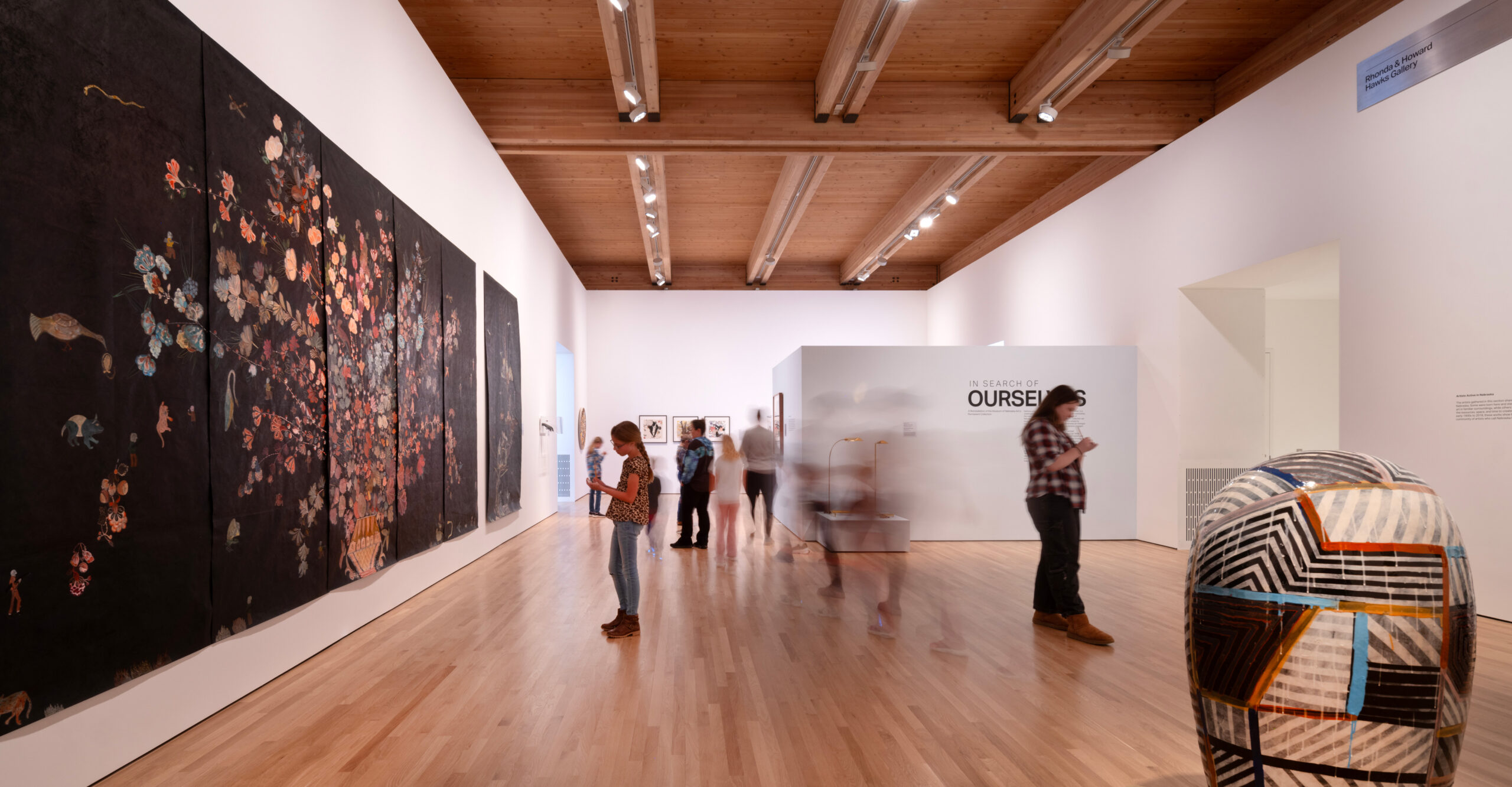 In Search of Ourselves: A Reinstallation of the Museum of Nebraska Art’s Permanent CollectionMay 3, 2025-July 2027
In Search of Ourselves: A Reinstallation of the Museum of Nebraska Art’s Permanent CollectionMay 3, 2025-July 2027
This reinstallation of MONA’s permanent collection surveys the entirety of the collection through a thematic lens—a significant shift from the Museum’s previous approach of presenting the collection chronologically by four eras: artist-explorers, early Nebraskans, modern artists, and art of today. In Search of Ourselves dives deeply into various areas of the permanent collection to explore the many ways “Nebraska art” has been defined through the Museum’s collecting practices.
Sponsored by The Terra Foundation for American Art, established in 1978 and with offices in Chicago and Paris, the foundation supports organizations and individuals locally and globally through its grant program, collection, and initiatives. Its aim is to foster intercultural dialogues and encourage transformative practices that expand narratives of American art.
Photograph © Nic Lehoux
Susan Knight: Groundwater Magic
Permanent Installation
There is a saying in Spanish, ojos que no ven, corazón que no siente, meaning
what the eyes don’t see, the heart does not feel. Under the Earth’s surface, groundwater in the soil accounts for ninety-eight percent of our usable water. The more porous the soil, the more groundwater it can hold. Susan Knight examines this porosity as a condition for sustaining life and regeneration.
Commissioned for the Museum of Nebraska Art’s permanent collection, Groundwater Magic comprises over eighty components of cut and painted Tyvek. Knight uses a laborious hand-cutting technique to create individual elements painted in red, yellow, gray, and green with acrylic ink. These colors correspond to hydrogeologists’ color-code system for clay, gravel, sand, and silt soil samples. Arranged together, these colorful disks and pods express the power to unite, circulate, and sustain.
